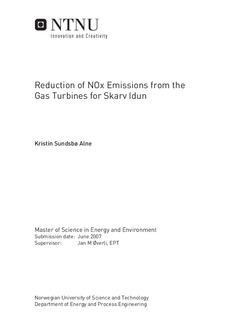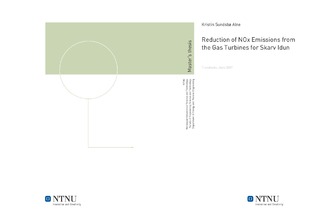| dc.description.abstract | Nitrogen oxides (NOx) are formed by oxidation of nitrogen during the combustion process, and production rate is highly affected by flame temperature. NOx is regarded as a local pollutant causing smog, acid rain and health complaints, and strictest emission regulations are found in urban areas. Reduction of NOx emissions from gas turbines can be achieved by modifying the combustion process or by exhaust gas clean up. Several technologies are already commercial available, but there are still a great many being developed. Increased focus on the environment also forces manufacturers to improve existing technology. In this report, different NOx abatement technologies are looked into, and an optimal solution for the coming gas turbines on Skarv Idun is presented. Different techniques are compared in terms of thermal efficiency, emissions, maintenance requirements, load acceptance and rejection, engine stability and reliability and availability. Application and suitability of available technologies for reducing NOx from the selected gas turbines is discussed, and user experience for these is collected. It is showed that all technologies influence operation of the gas turbines to some extent, either by increasing/decreasing efficiency or by affecting engine stability. They also differ in their ability to reduce NOx emissions over the entire load range. Due to weight and space restrictions on offshore installations, limited technologies are suitable for platforms and boats. Gas turbines installed offshore are usually aero-derivative engines with high efficiency and relative low emissions of CO2. This year, Norwegian government introduced a NOx tax in order to reduce NOx emissions from the petroleum industry. Operators are forced to use best available technology, and dry low emission control (DLE) is the only one considered qualified as far as NOx is concerned. DLE is also chosen as the optimal solution for the planned gas turbines on Skarv Idun, due to small operational impacts and positive experience from existing fields. It is however recommended to allocate space in case a new and better combustor with lower emission levels is developed. Looking at a longer perspective, Cheng technology including steam injection into the gas turbine combustor seems very promising for NOx abatement. | nb_NO |

